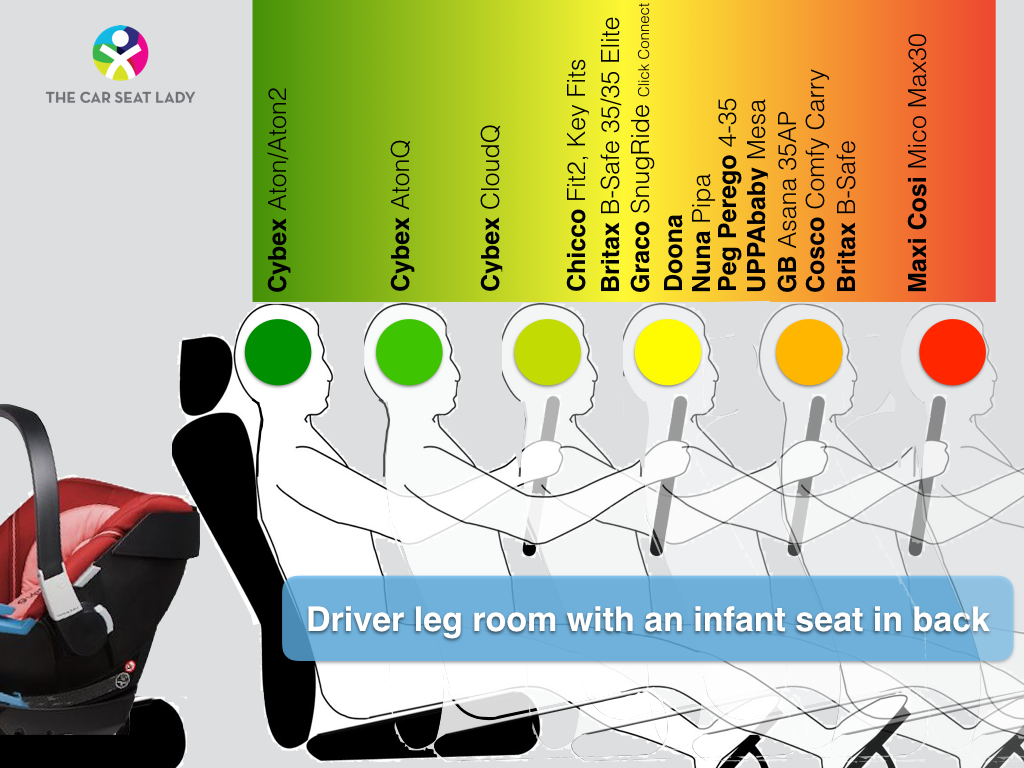Many parents think that the handle on an infant seat always has to be back when the carrier is in the car. This is not true! Many carriers allow – and some even require – that the handle be in other positions when riding in the car. Sometimes the requirement changes as the baby gets bigger or taller.
ALWAYS check your car seat’s instruction manual for the position your seat’s handle can be in during driving. Often this position is indicated on a label on the carrier as well as in the manual. If you can’t find the manual or a label, contact your car seat’s manufacturer and ask!
The problem with having the handle toward the front of the vehicle (in the “travel” position:
Rear-facing car seats often take up more room into the front seats than parents expect or want them to. With the handle in the “travel” position, where it rests slightly behind the baby’s head, the carrier becomes several inches longer front-to-back, and several inches wider side-to-side.
Positioning the handle here means the car seat takes up more room into the front seat, extra room that may prevent the car seat from fitting behind a taller adult in the front seat. And it becomes less likely to fit in the center of the back seat because it will often be too wide to nestle in the gap between the two front seats without forcing the driver and passenger to push their seats up.
The most versatile infant car seat allows the handle to be in the carry or anti-rebound position as these two positions will make it such that the car seat takes up as little room in the vehicle as possible. With the handle up, the carrier is more likely to fit securely in the center of the back seat, nestled between the two front seats, while still allowing the driver and front passenger enough room, or on the side behind a tall driver or passenger.
The image below shows how much room various infant seats take up into the front seat (all were measured with the handle in the position that the manufacturer allowed that took up the least amount of room into the front seat).
The image below shows how much room various infant seats take up into the front seat (all were measured with the handle in the position that the manufacturer allowed that took up the least amount of room into the front seat).

Why do many caregivers think the handle must be back, behind the carrier?
It’s all due to the design of the first infant carrier with a base ever sold in the United States, which hit the market in the mid 1980’s. On this particular seat – the Century 580 – you placed the infant carrier into the base with the handle up and then rotated the handle back to the store position to lock the carrier into the base. Forgetting to move the handle back meant that the carrier was not locked into the base, and could come out of the base in a crash! The Century 580, and its successor the 590, were the only infant carriers to feature this type of locking mechanism. All other seats lock automatically when you place the carrier in the base. Other manufacturers were concerned that if they allowed their seats to use the carry position, parents might mistakenly think it was OK to use the carry position on a Century 580/590, which could be a deadly mistake.
Since the last Century 590 left the factory in 1997 (and became too old to be used after 2003), manufacturers now feel comfortable recommending different handle positions. In fact, most seats in Europe use the handle in the carry position.
The table below lists the authorized handle positions for travel in the car for current and recently discontinued infant carriers. Please always double check the manual to your child’s seat. If the box is GREEN, this means you may use the handle in that position. If the box is gray, it means this car seat is no longer made. Click here for a printable version of the table.
